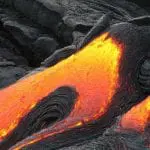“… the nuclear force. This force, while essential to the stability of all matter, is not well understood…
“The nuclear particles are held captive inside …the Coulomb barrier which confines the alpha particle. In nuclear alpha decay, the particle must pass through this barrier to gain its freedom from the nucleus. This…does not seem physically possible. The alpha particle is trapped inside the well, yet it somehow escapes. It is almost as if an object were to move directly through a solid wall…
“This discussion shows how little we actually know about the fundamental nature of matter on the smallest scale.”—pg, 144, 145, 149 “Thousands…Not Billions” by Dr. Don DeYoung
“As a young-earth creationist, I look at this issue in a different way. As I have stated previously, we just don’t know a lot about radioactive decay. Certainly not enough to justify the incredibly unscientific extrapolation necessary in an old-earth framework. “Scientist Realizes Important Flaw in Radioactive Dating,” April 3, 2017 — Dr. Jay Wile (http://blog.drwile.com/?p=15855). See also: http://blog.drwile.com/?p=297)
This is the fifth installment of our series, “Dinosaur Blood and the Real Age of the Earth,” and is a response to the book, “Dinosaur Blood and the Age of the Earth” by Fuz Rana of the Reasons to Believe organization headed by Hugh Ross. In Part 1 we took a look at the beliefs of Hugh Ross with special note taken of how Ross subverts biblical authority as a foundation to proclaim an old-earth theology. In Part 2 we looked at Rana’s Introduction and took special note of the nature of Rana’s argumentation as partisan polemics, and not objective scientific analysis. In Part 3 we examined Chapter 1, Rana’s citation of extant organic tissue from dinosaurs and other various organisms and the claim that they are millions of years old, with special note taken of Rana’s rejection of the empirical data contradicting this claim. In Part 4, we noted the short history regarding soft dinosaur tissue and took special note of the fact that many evolutionists (some to this day) denied the existence of soft extant dinosaur tissue; and we noted that the science of chemical kinetics allows of a maximum possible age of Mary Schweitzer’s famous tyrannosaurus rex of no more than about 10,000 years old.
Rana’s book is organized as follows:
Introduction: “What’s the Issue?”
Ch. 1: “Dinosaur Blood in Fossils: Who Would Believe It?”
Ch. 2: “Dinosaur Blood and the Case for a Young Earth”
Ch. 3: “Radiometric Dating and the Age of the Earth”
Ch. 4: “How Did Soft Tissue Survive in Dinosaur Fossils?”
Conclusion: “Should You Believe It or Not?”
Appendix A: “A Biblical Case for an Old Earth”
Appendix B: “The Creation-Evolution Controversy in Jurrasic World”
Appendix C: “Dinosaur Genome Size Estimates; Laggerstatten of Design”
In this article, we will be examining Chapter 3, “Radiometric Dating and the Age of the Earth”, pg. 37 – 51.
Radiometric Detour
In Chapter 2 of Fuz Rana’s book, “Dinosaur Blood and the Age of the Earth,” Rana laid out a reasonably accurate picture of the controversy between young-earth creationists and old-earth creationists about soft, extant dinosaur tissue. Rana specifically noted (young-earth creationist) Brian Thomas’ citation of collagen degradation experiments and the powerful challenge that this biochemistry poses to an old earth paradigm. Rana rightly conceded that collagen is perhaps the toughest of organic molecules, and the one that is likely to be able to endure the longest span of time before degrading, and that even collagen cannot persist for a million years, certainly not hundreds of millions of years, much less DNA, etc. Rana is therein laying the groundwork to propose his own rebuttal for the supposed ability of organic tissue to survive for several hundreds of millions of years.
But wait! Instead of making a biochemical argument at this juncture as would be logical and expected, Rana detours off into the unrelated discipline of nuclear physics–specifically the now-thoroughly-discredited radiometric dating. (By “unrelated,” I do not mean unrelated to the age of the earth but unrelated to biochemistry.) I find something a little mystifying about this: why does Rana jump directly from biochemistry to nuclear physics at this juncture? The subject under consideration is biochemistry (decay rates of soft extant original dinosaur tissue). Even if radiometric dating were entirely and firmly opposed to the proposition of a young earth as Rana claims (It’s not.), then this is still entirely irrelevant to all of the issues of biochemistry. So, for emphasis, I’ll ask the question again: why does Rana detour directly from biochemistry to nuclear physics at this juncture?
Radiometric Diversion
Asking the question supplies its own answer: Rana is not conducting objective scientific analysis of data in his book, but indulging yet again in partisan polemics and logical subterfuge. This is diversion. The obvious purpose of raising the unrelated issue of radiometric dating at this juncture, prior to advancing his biochemical speculations (which he reserves for the following chapter), is to divert the reader’s attention away from all of the contraindications that considerations of biochemistry raise. Rana’s purpose is to prop up his weak argument for an old earth based upon biochemistry with what Rana perceives as a better scientific foundation, namely, radiometric dating. Rana does not want his readers evaluating his biochemical arguments on their own merits. Rana wants to bias his readers against a young earth before considering his biochemical arguments, and he believes (mistakenly) that the field of radiometric dating accomplishes this. I find this radiometric diversion highly significant because it reveals that Rana has his own doubts about the ability of his biochemical arguments to “stand on their own two feet.”
When all is said and done, Rana rests his case for an old earth almost exclusively upon radiometric dating. Therefore, I will address the significant factors regarding radiometric dating shortly.
Radiometric Deception
In the Introduction to his book, Rana states that young-earth creationists
“insist that the scientifically determined dates for the fossils must be in error, because of the soft tissue recovered from these remains. In their view, these findings challenge the reliability of radiometric dating methods used to determine the age of these fossils, and along with it earth’s antiquity.”
To which I respond: No. False. Wrong. Erroneous. Incorrect. Mistaken. Inaccurate.
Rana appears willing to take advantage of the average reader’s unfamiliarity with these subjects in order to persuade them of his speculations. Rana is either deliberately muddying the waters here or he is himself pitifully confused about this issue. Rana is confusing and conflating two distinct issues. Young-earth creationists’ rejection of radiometric dating as a reliable timekeeper has nothing whatsoever to do with the discovery of soft dinosaur tissue. Extant soft dinosaur tissue is a newcomer to the arena of the debate about the age of the earth and fossils and so forth. Rana knows very well, or should know, that the criticisms of radiometric dating pre-date these soft tissue finds by several decades, as anyone can read, for example, in Henry Morris’ 1961 book, “The Genesis Flood” (see pages 331-377). In fact, the uncertainties of radiometric “dating” as a reliable timekeeper have been well understood by physicists since the very beginning of its use in the early 1900’s.
This subject has been thoroughly debated endlessly, ad infinitum, pro and con, since long before Mary Schweitzer astonished the world with her finds of soft dinosaur tissue. Whether deliberate or not, Rana’s contention here is a distortion of this fact and constitutes obscurantism, polemical sleight-of-hand.
The rejection of the reliability of radiometric “dating” of rocks and fossils is based upon its internal weaknesses, that is, the highly implausible assumptions at its foundation, and because of extreme discrepant results of actual radiometric testing. (See here, and here and here—, for example.) All of the points and criticisms raised against the reliability of radiometric dating were fully articulated long BEFORE any soft dinosaur tissue was ever discovered (or, more precisely, before it got any real recognition after Mary Schweitzer’s work). Young-earth creationists are saying that the existence of soft dinosaur tissue is simply CONSISTENT with those criticisms. It does not DIRECTLY relate to radiometric dating. It is simply confirmation coming from another unrelated field of science.
The criticisms of radiometric dating are not “based upon” the discovery of extant soft dinosaur tissue, as Rana seems to want people to believe. This is simply a proverbial “red herring.” Reading Rana’s book, one gets the impression that the deep-time interpretations that (mainly) atheistic, secular scientists ascribe to radiometric “dating” results were unanimously agreed upon by scientists…until, suddenly and recently, soft dinosaur tissue was discovered and then YEC’s began to repudiate radiometric dating. This distortion of the nature of the debate is strategic, and, therefore, gives the appearance of being deliberate subterfuge on Rana’s part. Granted, appearances can sometimes be deceiving, but that is certainly what it looks like. Rana is obviously well-acquainted with this issue so his argumentation at this juncture appears to be either deliberate distortion, or self-inflicted psychological denial, or just plain sloppy thinking–any one of which is equally appalling coming, especially as it does, from a Ph.D.-sporting biochemist.
Before scrutinizing Rana’s chapter on radiometric dating, I would like to resume on a comment I made in installment #2 of this series. I made the comment that Rana’s book is in some respects a very sloppy book. Aside from the sloppy “logic” of Rana’s argumentation already noted, Rana makes at least FIVE errors of fact in this chapter regarding Mark Armitage’s famous triceratops horn and the soft tissue from the triceratops Armitage discovered there. Rana states:
“…the results Thomas and Nelson obtained for the radiometric dating of the Triceratops horn make it impossible that the carbon-14 they detected was endogenous to (produced within) the soft tissue. Recall that Armitage and his associate Kevin Anderson (both YEC’s) uncovered soft, flexible brown sheets about 8 inches by 4 inches in size from the Triceratops fossilized horn after soaking pieces of it in a mild acid bath for a month.” –pg. 50
Rana sure knows how to pack a lot of error into a single paragraph. Here, itemized, are corrections to these factual errors Rana proffers:
- The triceratops horn pieces referenced were NOT fossilized (permineralized). They were original bone material.
- Therefore, the horn was not de-lithified (de-stoned) but decalcified. Again, the bone was not rock but actual bone.
- The famous 8 x 4 inch soft flexible sheet of tissue was not recovered from soaked bone (in the weak acid EDTA) as Rana mistakenly claims but from UNsoaked bone.
- Pieces of the interior of the horn were NOT submitted for C-14 testing.
- The soft sheets were NOT submitted for carbon-14 testing.
Mark Armitage, in discussing Rana’s comments and Rana’s errors of fact in “Dinosaur Blood and the Age of the Earth” notes the following, of which I quote at length:
“Chapter three of the book is a review of the radiometric dating methods. There are many fine resources available that discuss and expose this topic from a YEC and biblical point of view (for example, Vardiman, Snelling and Chaffin 2000, 2005). However, Rana (2016) must mount a vigorous reinforcement of radiometric dating at this juncture, because stunning soft dinosaur cells appear to throw these dating methods “under the bus.” Rana even writes on page 12, “The goal of chapter three is to demonstrate why radiometric dating is trustworthy” [emphasis in the original]. I find this to be a curious statement by a Ph.D. regarding an area of science that is supposedly beyond any incredulity, and beyond his expertise to adequately assess its validity or not.
“It reminds me of my early days in microscopy when working for Carl Zeiss, Inc., “The Great Name in Optics.” Training by Zeiss never focused on flaws in the product line of amazing microscopes. In fact, the training stressed that Zeiss microscopes were flawless. They offered the highest level of optical performance available on the planet. This was evidenced by the near total number of journal research papers that cited Zeiss as the microscopy equipment used in the research being reported. One never had to tell a potential client, “Let me tell you why Zeiss is trustworthy” -everyone knew that it was! Rana (2016) compounds this curious need to explain why radiometric dating is trustworthy by adding on page 13, “I will then offer a few reasons why I think these methods produce believable results” [emphasis mine]. If the product you are representing must be propped up by some reasons to believe that it is trustworthy and believable, and a great number of people suspect it to be otherwise, maybe it is time to represent another product.
“Nevertheless, Rana (2016) dives in to radiometric dating methods in Chapter three with a thorough enough review. He devotes significant time to the intricacies and technicalities of the methods, and that it requires the use of “experts who have spent years working with these techniques” (Chapter 3, p. 44) to understand it, and “geochemists who possess a good understanding” to get it right (Rana 2016, 45). He mentions in passing, however, that it can be “tricky” and that “rare exceptions do exist where chemical and physical processes do alter the radioactive decay rate” (Rana 2016, 41). It is a shame that he misses the opportunity to share with his readers that there has been an observed solar influence on some nuclear decay rates (Jenkins et al. 2012). If we are just now discovering influences on some decay rates such as these solar ones, who knows what other influences that we know nothing about might also alter these “constant” rates?
“It is in this chapter, however, that Rana (2016) must be corrected on two very important misrepresentations. The first is his conspicuous misunderstanding that “Armitage …uncovered soft, flexible brown sheets about 8 inches by 4 inches in size from the Triceratops fossilized horn after soaking pieces of it in a mild acid bath for a month” (Chapter 3, p. 50) [emphasis mine].
“Firstly, did Rana read our published paper (Armitage and Anderson 2013)? The Triceratops horn was not fossilized (permineralized). It responded to and was decalcified by the very weak acid EDTA that is used in pathology labs daily to dissolve bone. Next, he needed only to read the second sentence of the abstract to realize how wrong he is about the soaking of the bone in that acid and the “soft, flexible brown sheets”! Or he might have simply read the caption of figure 5 which reads, “Light micrograph, flap of fixed soft tissue (white arrow) slightly peeled away from undecalcified Triceratops bone specimen (black arrow)” [emphasis mine]. Regardless, our paper states on page 604, “Large strips of thin, light brown, soft material (20cm by I0cm) were recovered from the innermost sections of other fixed and unfixed, non-decalcified horn bone pieces” [emphasis mine]. In other words, the “soft, flexible brown sheets” that Rana refers to were found in un-soaked bone. There was no need to soak the bone in anything to get to them – they were simply lying there against hard bone.
“Secondly, Rana assumes that pieces of the horn containing these “soft, flexible brown sheets” were submitted to 14C dating, the results of which were reported by Thomas and Nelson (2015, 50-51). This is simply not the case. I know what was submitted and what was not submitted for radiocarbon dating.
“Based on this error, Rana (2016) builds a faulty argument supporting his contention that YEC’s make “it impossible that the 14C they detected was endogenous to (produced within) the soft tissue.” He contends that “that amount of (soft, flexible brown) material should have easily produced a strong 14C signal,” and that “It is impossible to reconcile the data reported with any scenario that would treat the flexible sheets of soft tissue as only 3000 to 6000 years old” (Rana 2016, 50).
“The piece of the Triceratops horn that was subjected (in this initial 14C testing) was not from the center of the bone where the “soft, flexible brown sheets” of fibrillar bone were found. I sent those researchers a chunk of the outer, weathered and fractured part of the 10-inch diameter horn. It is not surprising then that “older than expected” dates were received from the test because the specimen submitted was found upside down in the soil with all of its vascular elements facing up and exposed to rain, roots, microbes, insects etc, all of which might have degraded soft tissue in the outer bone.
“The soft sheets have not been tested for 14C. At some point in the future they will be submitted for 14C dating. Rana did not know this fact regarding what was submitted for testing at the time he wrote his book, but he could have asked.
“Therefore, his arguments with respect to the “older” than expected 14C age for the “soft, flexible brown sheets” of fibrillar bone which should have had “a strong 14C signal” (Rana 2016, 50-51) are invalidated. And he also ignores the well documented existence in the literature of strong 14C signals in fossil shells and bones, oils, coals and diamonds supposedly millions and billions of years old (Vardiman, Snelling and Chaffin 2005).”
I have to ask with Armitage: Did Rana actually read Armitage’s paper? I am sure some people reading my statements in Part 2 of this series judged me as being presumptuous, as a layperson, to characterize Rana’s work as a scientist as being “sloppy.” But these statements made by Rana are gross and easily-avoidable FACTUAL ERRORS concerning pivotal details that could have been avoided by simple due diligence. You don’t have to be a scientist to render a verdict here: “Dinosaur Blood and the Age of the Earth” is a sloppy work. My suspicion is that this sloppiness is due to haste in the effort to get the book published in a certain time frame spurred on by concerns about what this issue of soft dinosaur tissue is doing to donor support for the Reasons to Believe organization.
Radiometric Dating Debunked
Radiometric dating was one of the first subjects I dealt with when I first started writing here at The Creation Club. In fact, I thought it an important enough issue to make it a series of five parts. The reader is referred to those articles. (See Part 1, and Part 2, and Part 3, and Part 4 and Part 5.) Duane Caldwell also has an excellent article on the subject here.
Due to consideration of length, I will resume this discussion in Part 5B, and will delve into specific issues regarding radiometric dating, including some new information.
My next article will actually be a very brief departure from this series, “GENETIC ISOLATION OF SPECIES – OR EVOLUTION DISPROVEN IN THREE PARAGRAPHS.”
Featured Image credit: “Eternal Clock” by Robert van der Steeg








why do you even bother arguing with the people who think themselves evolved from monkeys after being exposed to Planet of Apes as impressionable children!
Darwin proved Earth is as young as The Bible states and he proved that the Flood really had been a catastrophic event qiite recently – which is why there is so much barren bedrock, sand and frozen soil about!
I, myself, was once a person who thought I was evolved from monkeys after being exposed to Planet of the Apes as a child. Show me a foolproof way to know who all of God’s elect are prior to regeneration and I will direct all of my comments only to them.